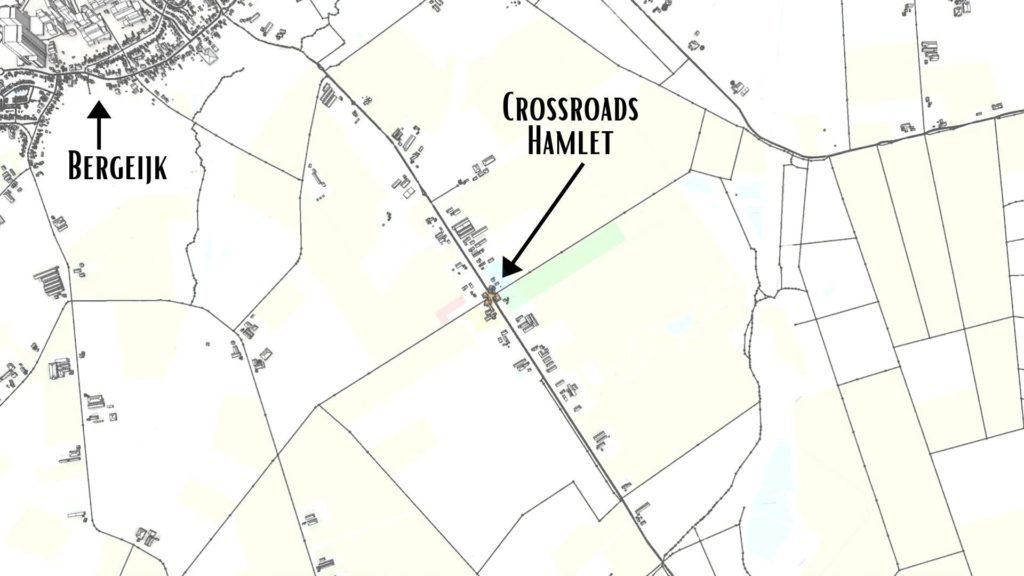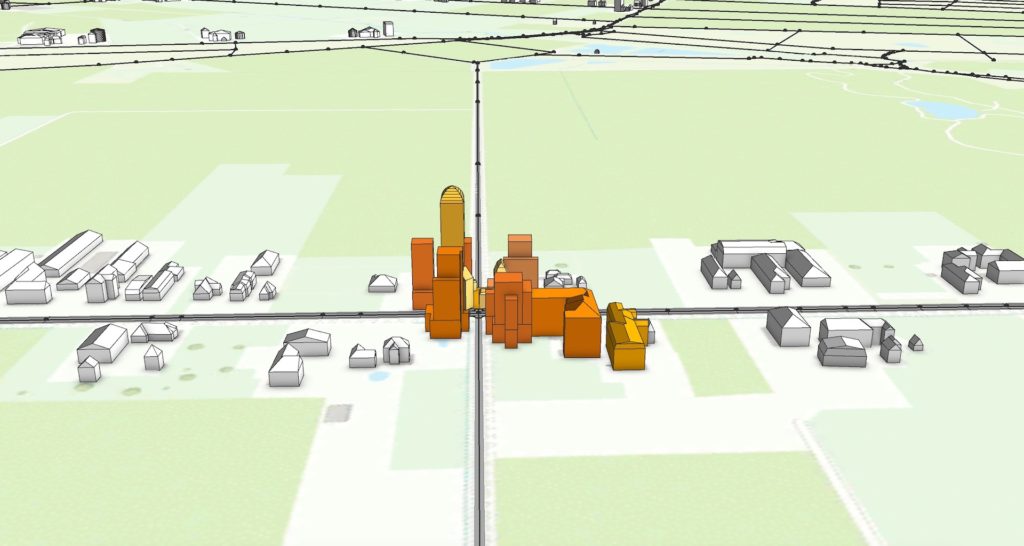This property experiment addresses these four regional problems in the Netherlands:
- Depopulation and the struggle for the social resiliency of the countryside.
- Feeling that the countryside is disappearing beneath ugly sprawl.
- Faceless and costly greenfield development and its traffic noise and congestion.
- The need to distribute population and tourism around the country.
The Crossroads Hamlet is a new-build micro development amongst the fields of the Dutch-Belgian border in the heart of Brabant.
The mix of rural and urban attributes has attracted an engaged community comprised of locals who have been living in the region for generations, living together with a few hundred newcomers mostly from the Randstad.
Crossroads Hamlet residents get to enjoy the positive attributes of small-scale urban living–such as incidental socialization and collaboration–while still being in the middle of the countryside.




Physical Description
The development is an example of ‘minimum viable urbanism’ as an activator of the countryside.
This micro-hamlet is a new architectural and urban design form adapted to life amongst the fields, which protects as much existing farmland as possible while also providing maximum social features and value.
Note: The following project renderings are not representative of the style or architectural details of the finished project. They only serve to represent the placement and relationship of the various building volumes.

One of the most distinctive features of the hamlet is the intersection at the base of the plan.
Between the four new tightly clustered mid-rise tower buildings, what was once a simple intersection between a gravel lane and a small country road is now a roundabout at the center of four short lengths of tunnel, supporting a plaza between the four towers above.
The different-sized buildings and lofted plaza create a silhouette similar to a tiny hill-town amongst the fields and forests.


Before the hamlet was built, the four adjacent properties were being used as farms, estate houses, and family-run campgrounds, which are continuing to operate virtually unchanged.
Hospitality and Public Space
Without a minimum level of socially focused capital and assets, local self-sustaining economy and culture are a struggle to maintain, especially in sparsely populated places.
Therefore, we made sure that the compact nature of this arrangement provides a critical mass of social attributes to trigger urban incidentalism.
For example, a small hotel in the hamlet serves as a single point for the hospitality needs of the region. The hotel lobby includes a small general store, a night shop, and a cafe, which together serve as a neighborhood gathering place. It’s a self-contained, miniature public space, perfectly scaled to an agrarian setting.
For any larger daily needs, residents can walk, bike, shuttle or drive just 2 km to the nearby village of Bergeijk, and the regional hub of Eindhoven is only 20 km away.
Engagement and Inclusion of an Existing Community
These hamlets are designed and intended to be good neighbors and to enhance their existing communities.
During the early development process, local residents were invited to explore the design plans and give input–ultimately helping to shape the outcome of the hamlet.
During this input process, many current local residents expressed their delight that Crossroads Hamlet would provide key missing community assets.
They were also relieved that the development would be tightly contained instead of sprawling–therefore adding public amenities while still respecting the surrounding farmland.
And the thought of having a few more friends around was especially appealing for the local kids.
After the hamlet was built, a few of the original residents who lived in houses right next to the corner even decided to relocate to some of the new loft apartments overlooking their fields in the countryside–giving them the best of both worlds.

Being so close to the village of Bergeijk, the hamlet has become a popular morning walk destination and a new place for an evening out just a short bike ride away. Having a rural region of 18,000 people in the immediate area makes such a unique spot an easy draw that becomes a self-sustaining economy.
Innovation, Activity, and Tourism
The new residents are mostly digital remote workers who enjoy the convenience of a mixed rural/urban life.
The hotel lobby gathering place includes a highly automated kitchen for the cafe and cashier-less checkout for the shop.
To allow for 24-hour service, there’s also a mix of innovative vending machines–serving everything from fresh-baked pizza to locally produced pre-packaged foods, to bicycle repair supplies. These solutions address the common problem of affording to maintain a regular staff in such a small place.
Having a close-by cafe in the hotel as a place to meet friends in the evening is also a great boost to everyone’s social lives.
And there’s plenty to do in and around the hamlet, with local sports activities, community gardens, and the cafe terrace right there above the crossroads.
The neighboring campground owners also love the development because it has attracted a new type of tourist, in the form of novelty-seeking ebike travelers who come nearly year-round.
A Potential 21st Century Dutch Hinterlands Renaissance
As we quickly approach the third decade of the 21st century, the Netherlands, like so many other places around the world, is dealing with the coexisting realities of countryside-destroying sprawl, noisy traffic congestion, and rural depopulation.
Starting around 2015, the Dutch government started publicizing the need to tackle these dual problems of rural depopulation and the blight of auto-dependent sprawl.
Concurrently, they put formal programs in place to encourage population and tourism distribution around the country to relieve the extreme pressure on the Randstad.
With this hilltop hamlet, we’ve provided just one version of a development form that we believe contributes to addressing these issues, while also being adaptable to many site-specific conditions and situations.
We believe models like the Crossroads Hamlet bring hope for a new era of countryside vitality–where agrarian productivity and residential tranquility coexist side-by-side.
Features:
- Walkable and cycling-friendly, utilizing the already world-class Dutch biking infrastructure throughout the region.
- Rock-climbing features on a few of the building faces.
- Sports and entertainment features like slackline, archery, BMX and pump track.
- Use of durable, high-quality building materials and techniques, which age well and have low ongoing maintenance costs.
- Architectural styles appropriate to the historical and agrarian setting.
- Automated cafe kitchen, cashier-less retail, and vending machines allowing 24-hour service in a small hamlet, which typically would be difficult and expensive to staff.
These pages explore experimental, hypothetical, forward-leaning design concepts. We mean no offense by these ideas, and we can assure you that they don’t currently exist…yet.
Check out our other Property Experiments here.


